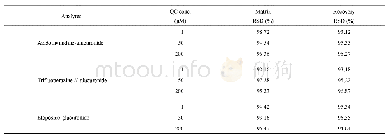《Table 3.Intra-/inter-day precision and accuracy of three probe drug metabolites (Mean±SD, n=6) .》
 提示:宽带有限、当前游客访问压缩模式
提示:宽带有限、当前游客访问压缩模式
本系列图表出处文件名:随高清版一同展现
《三七-红花有效组分复方对人肝微粒体中UGT1A1、1A4和2B7活性抑制作用的研究(英文)》
In our present study,etoposide[10],trifluoperazine[11]and azidothymidine[12]were selected as the probe drugs to evaluate the effects of CNS,NS and SF on the activities of UGT1A1,1A4 and 2B7 in HLMs,respectively.There were two control groups(group A and group B).Group A:probe drugs were incubated with HLMs in the absence of UDPGA;group B:probe drugs were incubated in the absence of HLMs.The probe drugs were stable in both control groups.Compared with the control group,4.4 mg/mL of CNS,4.8 mg/mL of NS and6.0 mg/mL of SF exhibited significant inhibition on UGT1A1,1A4 and 2B7 activities(P<0.05)with the IC50 values between 9.69±0.45 mg/mL to 27.66±2.14mg/mL in a concentration-dependent manner(Table 5).Typically,UGT1A1 and 1A4 are believed to be the key enzymes for the metabolism of bilirubin and nitrogen compounds[2],respectively.Meanwhile,UGT2B7 has been reported to be responsible for the glucuronidation of opioids,all C14,C16,C18,C20 saturated and unsaturated fatty acids[13].This finding above reminded us to focus on the HDI potency of CNS in clinic.
| 图表编号 | XD0045069100 严禁用于非法目的 |
|---|---|
| 绘制时间 | 2019.04.01 |
| 作者 | 李岩、孟雨晴、逯颖媛、常坤、高鹏、姜勇、屠鹏飞、郭晓宇 |
| 绘制单位 | 北京大学医学部药学院天然药物及仿生药物国家重点实验室、北京大学医学部药学院天然药物及仿生药物国家重点实验室、北京大学医学部药学院天然药物及仿生药物国家重点实验室、北京大学医学部药学院天然药物及仿生药物国家重点实验室、北京大学医学部药学院天然药物及仿生药物国家重点实验室、北京大学医学部药学院天然药物及仿生药物国家重点实验室、北京大学医学部药学院天然药物及仿生药物国家重点实验室、北京大学医学部药学院天然药物及仿生药物国家重点实验室 |
| 更多格式 | 高清、无水印(增值服务) |
查看“Table 3.Intra-/inter-day precision and accuracy of three probe drug metabolites (Mean±SD, n=6) .”的人还看了
-

- Table 6Recall,precision,f1-score,and accuracy rateaof the export of the Noisy-OR Bayesian function for COVID-19,IAVP,and





